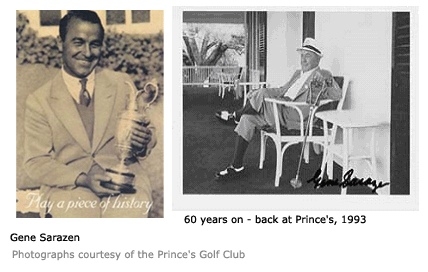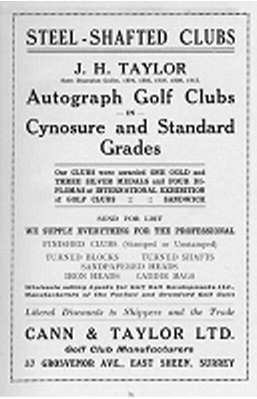|
The other advantage Sarazen had in that Open was to have the
services of Hagen’s old caddie, ‘Skip’ Daniels, who had worked for
Gene when he came second to the Haig in the 1928 Open at Royal St
George’s, after which he had told him: “I’m going to win the
Championship for you if it’s the last thing I do before I die”. By
1932 ‘Dan’, as Gene called him, was almost seventy with failing
health and poor eyesight. On the advice of Prince’s members Gene
reluctantly told him that he was not fit enough and employed a
younger man, but he did not get on with his new caddie and played
poorly in practise. He turned to Daniels again and with him on his
bag Gene’s game improved dramatically and he led from start to
finish to take the Claret Jug and the £100 first prize. His score of
283 was a record for the championship and left him five shots clear
of Macdonald Smith, in second place for the second time in three
years and six ahead of England’s Arthur Havers. You could say that I
had been an unwitting witness to the first steps in the modern era
of golf as 290 was broken for the first time using “the greatest
stroke saver in the game”, as Gene was to call it. His new ‘blaster’
was eventually recognised as one of the greatest advances in club
design, but it was a while before it came on the market and three or
four years passed before I had one in my bag. He got little out of
his invention, other than the prize money and titles it won him. His
equipment company, Wilson, claimed all the income from sales.
Sarazen requested that Daniels be allowed to join him for the
presentation ceremony, but this was sadly refused. Within months
Skip was dead. “When old Dan died the world was poorer by one
champion”, lamented Gene when he heard the news.
Playing with Gene was a tremendous experience for me in my first
championship and I am glad that I had the opportunity of playing
with this grand golfer. He went on to win the US Open that year and
became the highest paid sportsman in the world, when he signed a
contract worth an annual $25,000. Seventy years later the highest
paid golfer, Tiger Woods, earns a reputed $2.50 per second and,
bearing in mind that his rounds of golf take two hours longer than
Gene’s, Tiger surpasses Sarazen’s annual total early in the back
nine of a single day on the golf course.

 This was the last championship for the great Harry Vardon, who had
won the title six times between 1896 and 1914 - a record that still
stands. He failed to qualify and I did not have the opportunity to
make his acquaintance, but I did meet one of the Great Triumvirate
there - the five times Open champion, J. H. Taylor, who was a founder
member, and first chairman, of the PGA. He was then in his early
sixties and headed a golf club manufacturing company called Cann &
Taylor. I remember the scrupulous attention to detail in the making
of his clubs. When I was at Roehampton the Cann & Taylor clubhead
maker, Bert Nash, worked for my brother George in the evenings and
it was he who taught me clubmaking. He was a very hard taskmaster
and insisted on us meeting his own exacting standards. Everything
had to be ‘just so’, even down to the screws in the sole plates of
the woods being aligned with slots facing parallel from front to
back. This was the last championship for the great Harry Vardon, who had
won the title six times between 1896 and 1914 - a record that still
stands. He failed to qualify and I did not have the opportunity to
make his acquaintance, but I did meet one of the Great Triumvirate
there - the five times Open champion, J. H. Taylor, who was a founder
member, and first chairman, of the PGA. He was then in his early
sixties and headed a golf club manufacturing company called Cann &
Taylor. I remember the scrupulous attention to detail in the making
of his clubs. When I was at Roehampton the Cann & Taylor clubhead
maker, Bert Nash, worked for my brother George in the evenings and
it was he who taught me clubmaking. He was a very hard taskmaster
and insisted on us meeting his own exacting standards. Everything
had to be ‘just so’, even down to the screws in the sole plates of
the woods being aligned with slots facing parallel from front to
back.
In the thirties Bert’s younger brother Harry worked for the Aga Khan
and often accompanied him during rounds at Roehampton. Harry
described the
NEXT |


 This was the last championship for the great Harry Vardon, who had
won the title six times between 1896 and 1914 - a record that still
stands. He failed to qualify and I did not have the opportunity to
make his acquaintance, but I did meet one of the Great Triumvirate
there - the five times Open champion, J. H. Taylor, who was a founder
member, and first chairman, of the PGA. He was then in his early
sixties and headed a golf club manufacturing company called Cann &
Taylor. I remember the scrupulous attention to detail in the making
of his clubs. When I was at Roehampton the Cann & Taylor clubhead
maker, Bert Nash, worked for my brother George in the evenings and
it was he who taught me clubmaking. He was a very hard taskmaster
and insisted on us meeting his own exacting standards. Everything
had to be ‘just so’, even down to the screws in the sole plates of
the woods being aligned with slots facing parallel from front to
back.
This was the last championship for the great Harry Vardon, who had
won the title six times between 1896 and 1914 - a record that still
stands. He failed to qualify and I did not have the opportunity to
make his acquaintance, but I did meet one of the Great Triumvirate
there - the five times Open champion, J. H. Taylor, who was a founder
member, and first chairman, of the PGA. He was then in his early
sixties and headed a golf club manufacturing company called Cann &
Taylor. I remember the scrupulous attention to detail in the making
of his clubs. When I was at Roehampton the Cann & Taylor clubhead
maker, Bert Nash, worked for my brother George in the evenings and
it was he who taught me clubmaking. He was a very hard taskmaster
and insisted on us meeting his own exacting standards. Everything
had to be ‘just so’, even down to the screws in the sole plates of
the woods being aligned with slots facing parallel from front to
back.